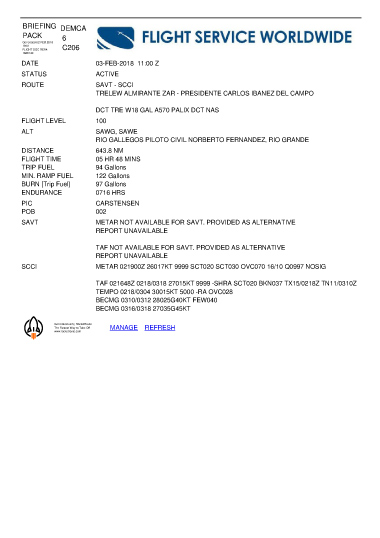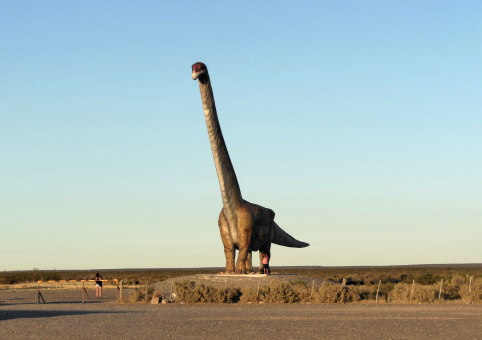Flight Log: Trelew SAVT -- Punta Arenas SCCI 03.02.2018/04.02.2018/05.02.2018


03 February 2018, Trelew — Punta Arenas:
We only had a very small breakfast, but did manage two biscuits each. On the way to the airfield, we passed a vast creature, a dinosaur that had been reconstructed based on finds in Patagonia.
Everything appeared to be going smoothly at the airfield. We got on particularly well with a woman from air traffic control and everybody was indeed very friendly. The baggage was checked and stowed in the plane. The general declaration was signed and we thought we were all ready for the off. However, a customs officer suddenly appeared and asked us to unload the baggage again and have it screened. Not everything always goes to plan and I feared that the customs officer might take the whole plane apart and cause a delay. But that wasn’t the case. It turned out that it hadn’t got anything to do with us but was due to ill feelings between the male and the female customs officer. In his view, he’d been ignored. So we sent our baggage through security screening again, I showed everyone my laptop and we were able to put our stuff back in the plane. Everything was OK and our customs officer was suddenly really friendly and we were able to take off with only a 15-minute delay.
We reached the Atlantic half an hour later close to the town of Comodore, taking in Patagonia’s landscape from an altitude of 3,000 m and the small Santa Salamanca hills. Accompanied by pleasant headwind of 10 to 15 knots and side wind of about 25 knots, we headed for Tierra del Fuego. We gazed down on the town of Puerto Santa Cruz and the structures of a vast dried-out river. Indeed, we were fascinated by the many salt dunes during the whole of the flight. At the moment, we can’t imagine how they formed in Patagonia and wanted to find that out.
We hadn’t had much for breakfast, so ate up our supplies of dry food to keep the wolf from the door. When we passed by the alternative airfield, everything carried on in the same way with about 10 knots of headwind, 20 knots of side wind, calm weather and sunshine. But then we saw a chain of cumulus clouds in the distance that weren’t the usual light type, but more grey. As we came nearer, this formation gained more of a structure and on the horizon you could see a vast sleeve, about 80 to 100 km long from left to right and at an altitude of 10,000 feet or 3,000 m. We assumed that these weren’t normal cumulus clouds but an enormous squall, which happens when air masses pass over mountains at very high speed and pile up behind the mountains like a large sleeve. This is intensified when the air mass coming over the mountain range collides with another air mass moving in another direction. As we got nearer and Marie suddenly had to pull up her nose to maintain altitude, we realised we were right. In other words, we were confronted with air masses that were dropping rapidly and that the plane had to compensate for by ascending. The engine had to be reset in order to be able to cope with this sharp ascent. Our ground speed dropped to 80 knots per hour although the headwind was no more than 10 knots. In other words, the plane had to lose speed due to the ascent. At the same time, the side wind increased enormously and rose to over 70 knots during the rest of the flight. Once we’d reached the visible part of the squall, in other words the area where the air condensates and clouds form, we were in the second half of the squall where there was very strong upwind. Now Marie was pointing her nose steeply downwards so as not to be swept over the required altitude of 3,000 m. This meant that Marie flew at a speed of 175 knots per hour for a time because she was in a sharp descent and the altitude of 3,000 m was maintained nevertheless. We pilots have never experienced such a massive squall extending over what appeared to be very flat terrain.
In the meantime, we contacted the tower in Punta Arenas whose controller sent wind forecasts and prepared us for what could be a tricky landing. He reported wind speeds and wind directions at levels of 1,000 feet, for example:
Wind at 4,000 feet; 290°; 50 knots
Wind at 2,000 feet; 285°; 38 knots
Wind at 1,000 feet; 280°; 36 knots
Wind at 200 feet; 280°; 35 knots
Of course, this does indicate the wind speed but not how gusty it is, particularly at a low altitude and when our designated runway 30 has a small hill in front of it that could lift up the air mass and the plane only to pull it down again once it has got over the hill. So the weather was more than just a bit difficult and the wind came from 280° at 35 to 40 knots, in other words slightly from the side, when the landing direction was at 300°.
We approached slightly too fast and the plane ascended initially but at too high speed so that it jumped up again about two metres from the runway and it took a second go for it to roll softly onto the runway so that we could move away from it. The controller in the tower said: “Once you’re safely on the runway, you can taxi on to the next position on the right.”
We were immediately led to the aviation fuel pumps where we filled up Marie. That proved to be quite difficult because the ground wind was so strong that some of the aviation fuel was sucked out of the tank opening and sprayed around. The pump attendant’s tube was also much too large for the aviation fuel. It didn’t fit into Marie’s tank opening so he used a funnel, poured the aviation fuel into that and then into the tanks via a little pipe. The tank was filled up accompanied by ear-splitting noise from the wind and engines of a Transall military plane.
Our handling agent had found somewhere where we could park Marie in a relatively protected space behind a hangar and secure her with a few blocks to make sure nothing untoward happened once we had filled her up. The handling agent said he would get the immigration papers completed while we went to the hotel. We would then get these papers back on departure. We made our way to the taxi rank and were surprised to see a young Chilean man with a placard with Uwe Thomas Carstensen on it at the airport exit. We approached him and it transpired he’d been sent by “Dear Grace”, our Antarctic flight supervisor, to take us to the hotel. And that was the end of the day’s events.
Bye for now.
 Loading. Please wait...
Loading. Please wait...


















